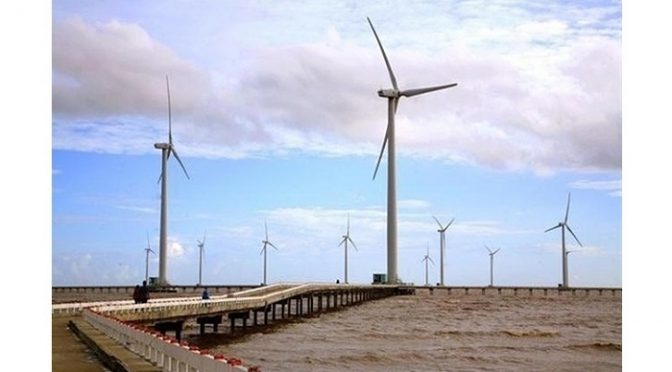| According
to the Vietnam Energy Association (VEA), wind power can replace coal
and gas thermal power, while being capable of generating power for 24
hours a day. Therefore, developing wind power, especially offshore wind
projects, will be the key to replace fossil energy that is currently
used the most.
Vietnam has an estimated total wind capacity of 513,360 MW, the
largest in Southeast Asia, six times higher than the expected capacity
of the whole domestic electricity industry in 2020 and much larger than
the potential of other countries in the region, such as Thailand
(152,392 MW), Laos (182,252 MW) and Cambodia (26,000 MW). However,
Vietnam has just put into operation several wind power projects with a
total capacity of over 300 MW, still slower than the target of 800 MW by
2020 stated in the adjusted national electricity development planning
for the 2011-2020 period (Power Development Master Plan VII) approved by
the Government in 2016.
At a recent Hanoi seminar discussing the planned Thang Long offshore
wind power project, organised by the British Embassy in Vietnam, the VEA
and Enterprize Energy Group, Ambassador of the United Kingdom of Great
Britain and Northern Ireland in Vietnam, Gareth Ward, stated that
according to the Energy Sector Management Assistance Programme (ESMAP)
report, Vietnam has offshore wind resources similar to the UK.
Therefore, the British Government is eager to assist Vietnam in
exploiting the resource to meet the national energy goals.
Talking about Vietnam’s wind power potential, VEA Chairman Tran Viet
Ngai, said that after solar power, wind power will be also be a clean
energy solution for Vietnam because of its huge potential. Currently,
the development trend of offshore wind power is gaining much attention
in the country.
According to Ngai, the Government, the Ministry of Industry and Trade
(MOIT) and the Vietnam Electricity (EVN) have determined that from 2020
to 2023, at the current pace of development, the country would likely
suffer a shortage of electricity, if the projects under the Power
Development Master Plan VII (revised) continue to be lagging behind
schedule.
Recently, the Prime Minister and the MOIT have allowed the Enterprize
Energy Group to study and survey the Thang Long offshore wind power
project off the Ke Ga cape in Binh Thuan province’s coast, with a
capacity of 3,400 MW and a total investment up to US$11.9 billion. As a
huge potential offshore wind power project, it would provide a huge
amount of clean electricity to the national grid, thus contributing to
solving the shortage of energy, especially in the southern region.
Sharing the same opinion with Ngai, Liming Qiao, Asia Director of the
Global Wind Energy Council, said that with great potential in wind
power, Vietnam will be an attractive investment destination if it can
ensure stable and long lasting legal framework. She suggested that
Vietnam makes more efforts to improve the efficiency and transparency of
market regulations as well as the procurement process, while
standardising electricity trading contracts and simplifying project
approval process in order to motivate investors to enter the market.
While the national electricity supply is facing difficulties, Ngai
said that the early inclusion of renewable energy projects, with great
potential as Thang Long offshore wind power project, into the national
electricity development planning is absolutely essential. The inclusion
of projects into the Government’s electricity planning, in addition to
facilitating the projects to enter the stage of signing contracts to
deploy investment activities, provides the basis for the relevant
agencies to update the planning for connecting the projects into the
grid, as well as helping to clearly define investment in power
transmission systems, lines and power stations, thus ensuring the
project capacity and the local absorption ability in the projects’
areas.
As the investor of Thang Long offshore wind power project, Enterprize
Energy Chairman, Ian Hatton, said with appropriate and stable policies
from the Government of Vietnam, as well as a reasonable power purchase
agreement and the use of proven turbine technology from reputable
contractors for manufacturing and installation, international banks
would ensure sufficient capital for the project implementation.
Recently, the Prime Minister and the MOIT have agreed to allow
Enterprize Energy to research and survey the Thang Long offshore wind
power project. The investor has completed the elaboration of additional
electricity planning and submitted it to the MOIT for appraisal.
Ian Hatton also expressed his wish that the project would soon be
approved by the Government to be added to the Power Development Master
Plan VII, so that by 2023 its first turbine would start generating
electricity. The success of the Thang Long offshore wind power project
would provide a huge amount of clean electricity for Vietnam’s
electricity system, contributing to ensuring energy security and
environmental protection in the future, he said.
From the local perspective, Ha Le Thanh Chung, Deputy Head of the
Binh Thuan Provincial Department of Industry and Trade, said that the
investment in wind power projects is consistent with the national
orientation of developing renewable and clean energy sources, while also
in line with the goal of turning Binh Thuan into a clean energy hub of
Vietnam. |

